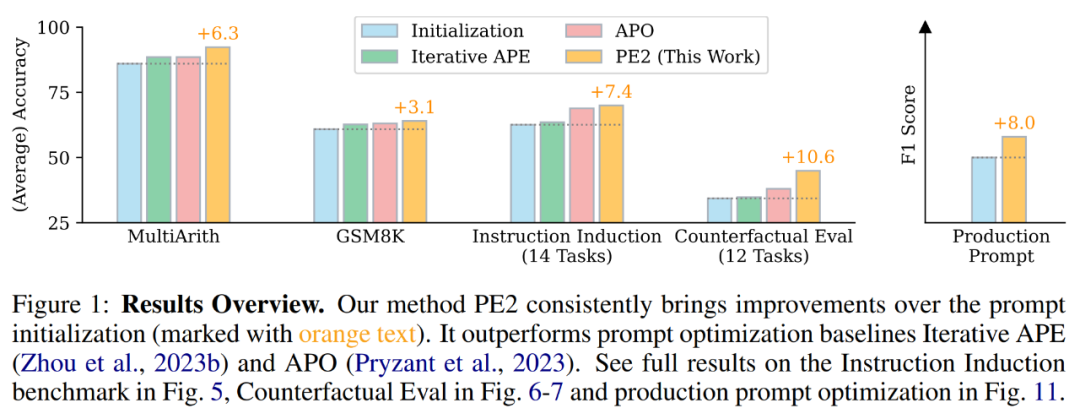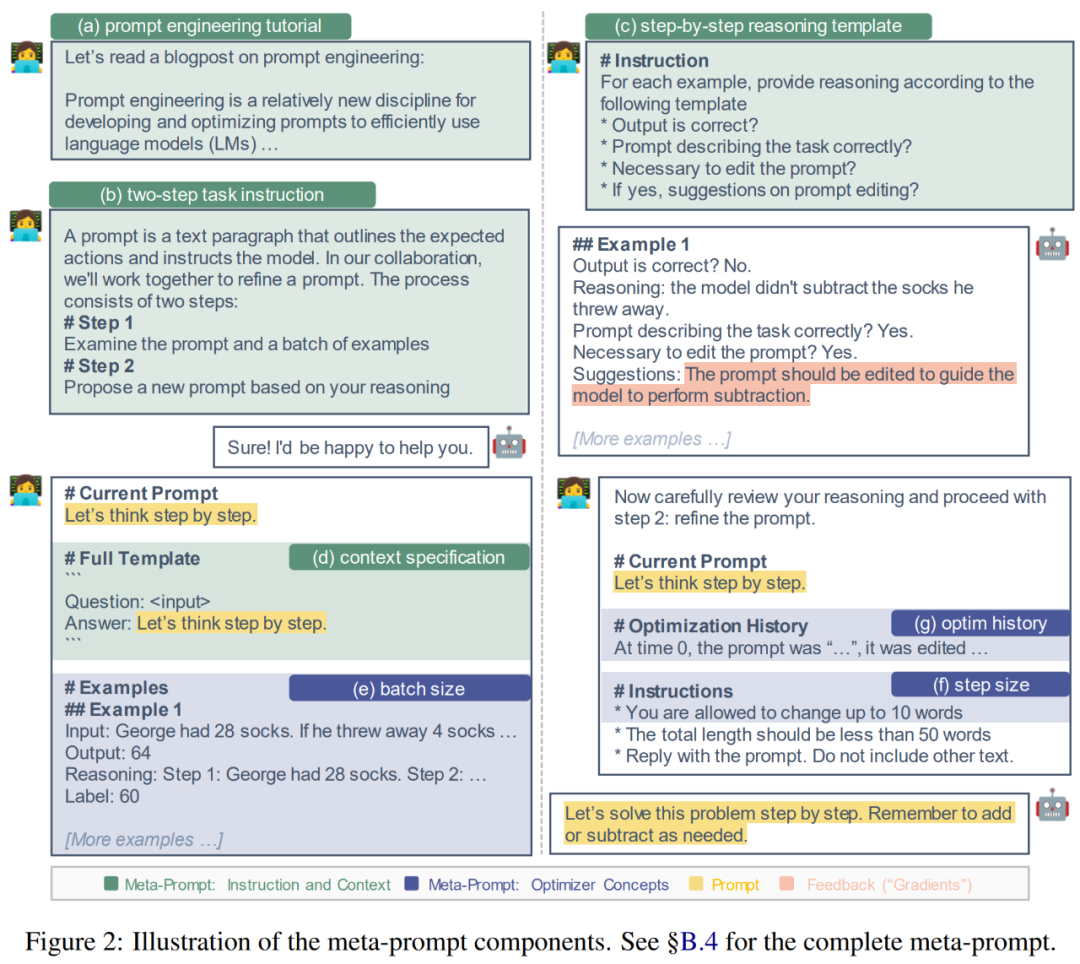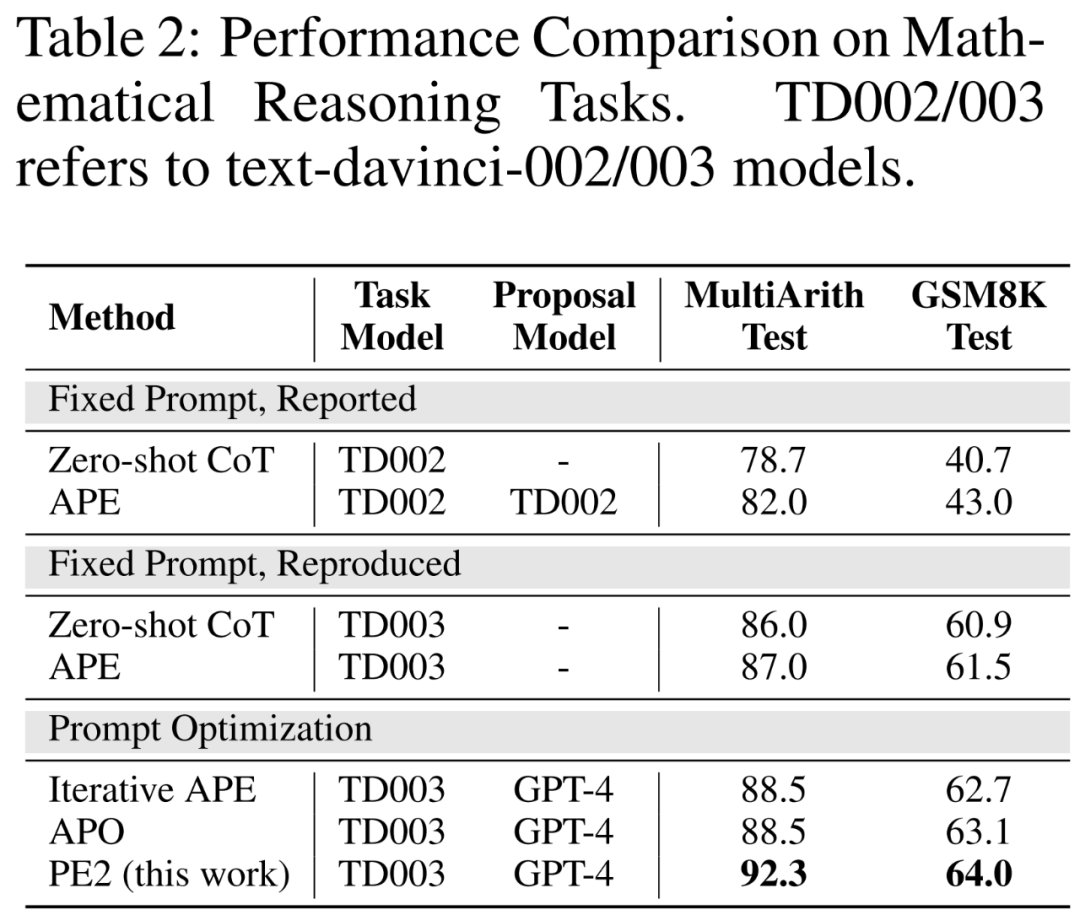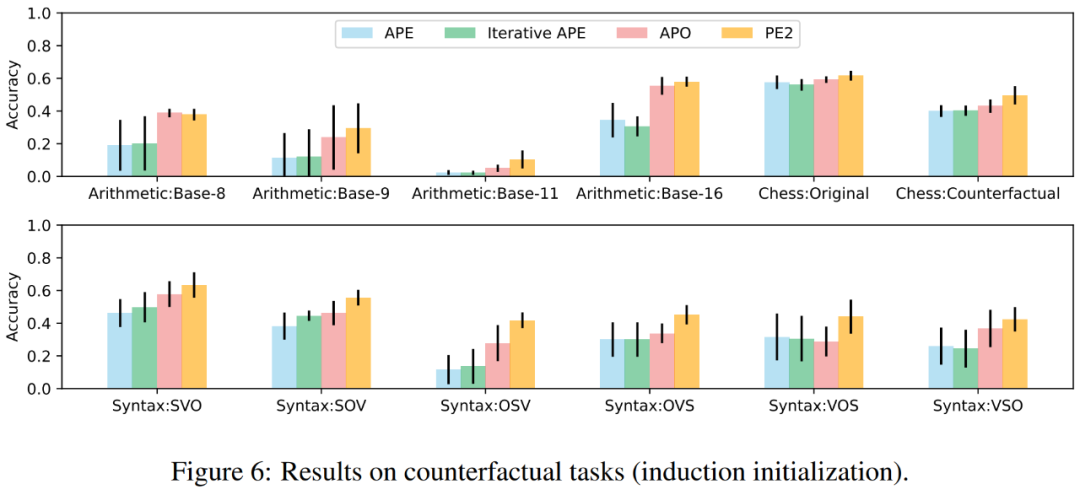 Technology peripherals
Technology peripherals
 AI
AI
 More effective than the mantra 'Let's think step by step', it reminds us that the project is being improved.
More effective than the mantra 'Let's think step by step', it reminds us that the project is being improved.
More effective than the mantra 'Let's think step by step', it reminds us that the project is being improved.
Large language models can perform automatic hint engineering through meta-hints, but their potential may not be fully realized due to the lack of sufficient guidance to guide complex reasoning capabilities in large language models. So how to guide large language models to carry out automatic prompt projects?
Large language models (LLMs) are powerful tools in natural language processing tasks, but finding optimal cues often requires a lot of manual trial and error. Due to the sensitive nature of the model, even after deployment to production, unexpected edge cases may be encountered requiring further manual tuning to improve prompts. Therefore, although LLM has great potential, manual intervention is still required to optimize its performance in practical applications.
These challenges have given rise to the emerging research field of auto-cue engineering. One notable approach in this area is by leveraging LLM's own capabilities. Specifically, this involves using instructions to meta-cue LLM, such as "check the current prompt and sample batch, then generate a new prompt".
While these methods achieve impressive performance, the question that arises is: what kind of meta-hints are suitable for auto-hint engineering?
To answer this question, researchers from the University of Southern California and Microsoft discovered two key observations. First, prompt engineering itself is a complex language task that requires deep reasoning. This means carefully examining the model for errors, determining whether some information is missing or misleading in the current prompt, and finding ways to communicate the task more clearly. Secondly, in LLM, complex reasoning capabilities can be stimulated by guiding the model to think step by step. We can further improve this capability by instructing the model to reflect on its output. These observations provide valuable clues for solving this problem.

Paper address: https://arxiv.org/pdf/2311.05661.pdf
Through the previous observations, the researcher conducted a fine-tuning project, aiming to Establishing a meta-hint provides guidance for LLM to perform hint engineering more efficiently (see Figure 2 below). By reflecting on the limitations of existing methods and incorporating recent advances in complex reasoning prompts, they introduce meta-cue components such as step-by-step reasoning templates and context specifications to explicitly guide LLM's reasoning process in prompt engineering.
Additionally, since hint engineering is closely related to optimization problems, we can borrow some inspiration from common optimization concepts such as batch size, step size, and momentum and introduce them into meta-hints for improvements . We experimented with these components and variants on two mathematical inference datasets, MultiArith and GSM8K, and identified a top-performing combination, which we named PE2.
PE2 has made significant progress in empirical performance. When using TEXT-DAVINCI-003 as the task model, PE2-generated prompts improved by 6.3% on MultiArith and 3.1% on GSM8K over the step-by-step thinking prompts of the zero-shot thinking chain. Furthermore, PE2 outperforms the two auto-prompt engineering baselines, namely iterative APE and APO (see Figure 1).
It is worth noting that PE2 performs most effectively on the counterfactual task. Additionally, this study demonstrates the broad applicability of PE2 to optimizing lengthy, real-world prompts.

In reviewing PE2's prompt editing history, researchers found that PE2 consistently provides meaningful prompt editing. It is able to fix incorrect or incomplete hints and make the hints richer by adding additional details, resulting in an ultimate performance improvement (shown in Table 4).
Interestingly, when PE2 does not know addition in octal, it makes its own arithmetic rules from the example: "If both numbers are less than 50, add 2 to the sum. If one of the numbers is 50 or greater, add 22 to the sum." Although this is an imperfect and simple solution, it demonstrates PE2's remarkable ability to reason in counterfactual situations.
Despite these achievements, researchers have also recognized the limitations and failures of PE2. PE2 is also subject to limitations inherent in LLM, such as the plausibility of ignoring given instructions and generating errors (shown in Table 5 below).

Background knowledge
Prompt project
The goal of the prompt project is to find the text prompt p∗ that achieves the best performance on the given data set D when using the given LLM M_task as the task model (as shown in the following formula). More specifically, assume that all data sets can be formatted as text input-output pairs, i.e., D = {(x, y)}. A training set D_train for optimization hints, a D_dev for validation, and a D_test for final evaluation. According to the symbolic representation proposed by the researcher, the prompt engineering problem can be described as:

Among them, M_task (x; p) is generated by the model under the condition of given prompt p output, and f is the evaluation function for each example. For example, if the evaluation metric is an exact match, then 
Use LLM for auto-prompt engineering
Auto-prompt given an initial set of prompts Engineers will continually come up with new and possibly better tips. At timestamp t, the prompt engineer gets a prompt p^(t) and expects to write a new prompt p^(t 1). During the generation of a new hint, one can optionally examine a batch of examples B = {(x, y, y′ )}. Here y ′ = M_task (x; p) represents the output generated by the model and y represents the true label. Use p^meta to represent a meta-prompt that guides LLM's M_proposal to propose new proposals. Therefore,

Building a better meta-cue p^meta to improve the quality of the proposed hint p^(t 1) is the main focus of this study.
Building better meta-cues
Just like cues play an important role in the final task performance, the meta-cue p^meta introduced in Equation 2 is in the new Plays an important role in the quality of the prompts presented and the overall quality of the automated prompts project.
Researchers mainly focus on hint engineering of meta-cue p^meta, developed meta-cue components that may help improve the quality of LLM hint engineering, and conducted systematic ablation research on these components.
The researchers designed the basis of these components based on the following two motivations: (1) Provide detailed guidance and background information; (2) Incorporate common optimizer concepts. Next, the researchers describe these elements in more detail and explain the underlying principles. Figure 2 below is a visual representation.

Provide detailed instructions and context. In previous studies, meta-cues either instructed the proposed model to generate a paraphrase of the prompt or contained minimal instructions about examining a batch of examples. Therefore it may be beneficial to add additional instructions and context to meta-cues.
(a) Prompt engineering tutorial. To help LLM better understand the task of prompt engineering, the researchers provide an online tutorial on prompt engineering in Meta-Click.
(b) Two-step task description. The prompt engineering task can be decomposed into two steps, as done by Pryzant et al.: In the first step, the model should examine the current prompt and a batch of examples. In the second step, the model should build an improved prompt. However, in Pryzant et al.'s approach, each step is explained on the fly. Instead, the researchers considered clarifying these two steps in the metacue and conveying expectations upfront.
(c) Step-by-step reasoning template. To encourage the model to carefully examine each example in batch B and reflect on the limitations of the current prompt, we guided the prompt proposal model M_proposal to answer a series of questions. For example: Is the output correct? Does the prompt describe the task correctly? Is it necessary to edit the prompt?
(d) Context specification. In practice, there is flexibility in where hints are inserted throughout the input sequence. It can describe the task before entering the text, such as "translate English to French." It can also appear after inputting text, such as "think step by step" to trigger reasoning skills. To recognize these different contexts, researchers explicitly specify the interaction between cues and input. For example: "Q: A: Think step by step."
Incorporate common optimizer concepts. The cue engineering problem described previously in Equation 1 is essentially an optimization problem, while the cue proposal in Equation 2 can be viewed as undergoing an optimization step. Therefore, researchers consider the following concepts commonly used in gradient-based optimization and develop their counterparts for use in meta-cues.
(e) Batch size. The batch size is the number of (failed) examples used in each tip proposal step (Equation 2). The authors tried batch sizes of {1, 2, 4, 8} in their analysis.
(f) step size. In gradient-based optimization, the step size determines how much the model weights are updated. In a prompt project, its counterpart might be the number of words (tokens) that can be modified. The author directly specifies "You can change up to s words in the original prompt", where s ∈ {5, 10, 15, None}.
(g) Optimize history and momentum. Momentum (Qian, 1999) is a technique that speeds up optimization and avoids oscillations by maintaining a moving average of past gradients. To develop the linguistic counterpart of momentum, this paper includes a summary of all past prompts (time stamped 0, 1, ..., t − 1), their performance on the dev set, and prompt edits.
Experiment
The author uses the following four sets of tasks to evaluate the effectiveness and limitations of PE2:
1. Mathematical reasoning; 2. Instruction induction ; 3. Counterfactual evaluation; 4. Production prompts.
Improved benchmarks and updated LLMs. In the first two parts of Table 2, the authors observe significant performance improvements using TEXT-DAVINCI-003, indicating that it is more capable of solving mathematical reasoning problems in Zero-shot CoT. Furthermore, the gap between the two cues decreased (MultiArith: 3.3% → 1.0%, GSM8K: 2.3% → 0.6%), indicating reduced sensitivity of TEXT-DAVINCI-003 to cue interpretation. For this reason, methods that rely on simple paraphrases, such as Iterative APE, may not be effective in improving the final results. More precise and targeted prompt editing is necessary to improve performance.

#PE2 outperforms Iterative APE and APO on a variety of tasks. PE2 is able to find a tip with 92.3% accuracy on MultiArith (6.3% better than Zero-shot CoT) and 64.0% on GSM8K (3.1%). Furthermore, PE2 found cues that outperformed Iterative APE and APO on the instruction induction benchmark, counterfactual evaluation, and production cues.
In Figure 1 above, the author summarizes the performance improvements achieved by PE2 on the instruction induction benchmark, counterfactual evaluation, and production prompts, demonstrating that PE2 achieves strong performance on various language tasks. Notably, when using inductive initialization, PE2 outperforms APO on 11 out of 12 counterfactual tasks (shown in Figure 6), demonstrating PE2’s ability to reason about paradoxical and counterfactual situations.

PE2 generates targeted prompt editing and high-quality prompts. In Figure 4(a), the authors plot the quality of the cue proposals during the cue optimization process. A very clear pattern was observed across the three cue optimization methods in the experiments: Iterative APE is based on paraphrasing, so the newly generated cues have smaller variance. APO undergoes drastic prompt editing, so performance degrades on the first step. PE2 is the most stable of the three methods. In Table 3, the authors list the best tips found by these methods. Both APO and PE2 can provide "consider all parts/details" instructions. Additionally, PE2 is designed to scrutinize batches, enabling it to go beyond simple paraphrase edits to very specific prompt edits such as "Remember to add or subtract as needed."

For more information, please refer to the original paper.
The above is the detailed content of More effective than the mantra 'Let's think step by step', it reminds us that the project is being improved.. For more information, please follow other related articles on the PHP Chinese website!

Hot AI Tools

Undresser.AI Undress
AI-powered app for creating realistic nude photos

AI Clothes Remover
Online AI tool for removing clothes from photos.

Undress AI Tool
Undress images for free

Clothoff.io
AI clothes remover

AI Hentai Generator
Generate AI Hentai for free.

Hot Article

Hot Tools

Notepad++7.3.1
Easy-to-use and free code editor

SublimeText3 Chinese version
Chinese version, very easy to use

Zend Studio 13.0.1
Powerful PHP integrated development environment

Dreamweaver CS6
Visual web development tools

SublimeText3 Mac version
God-level code editing software (SublimeText3)

Hot Topics
 1378
1378
 52
52
 The author of ControlNet has another hit! The whole process of generating a painting from a picture, earning 1.4k stars in two days
Jul 17, 2024 am 01:56 AM
The author of ControlNet has another hit! The whole process of generating a painting from a picture, earning 1.4k stars in two days
Jul 17, 2024 am 01:56 AM
It is also a Tusheng video, but PaintsUndo has taken a different route. ControlNet author LvminZhang started to live again! This time I aim at the field of painting. The new project PaintsUndo has received 1.4kstar (still rising crazily) not long after it was launched. Project address: https://github.com/lllyasviel/Paints-UNDO Through this project, the user inputs a static image, and PaintsUndo can automatically help you generate a video of the entire painting process, from line draft to finished product. follow. During the drawing process, the line changes are amazing. The final video result is very similar to the original image: Let’s take a look at a complete drawing.
 Topping the list of open source AI software engineers, UIUC's agent-less solution easily solves SWE-bench real programming problems
Jul 17, 2024 pm 10:02 PM
Topping the list of open source AI software engineers, UIUC's agent-less solution easily solves SWE-bench real programming problems
Jul 17, 2024 pm 10:02 PM
The AIxiv column is a column where this site publishes academic and technical content. In the past few years, the AIxiv column of this site has received more than 2,000 reports, covering top laboratories from major universities and companies around the world, effectively promoting academic exchanges and dissemination. If you have excellent work that you want to share, please feel free to contribute or contact us for reporting. Submission email: liyazhou@jiqizhixin.com; zhaoyunfeng@jiqizhixin.com The authors of this paper are all from the team of teacher Zhang Lingming at the University of Illinois at Urbana-Champaign (UIUC), including: Steven Code repair; Deng Yinlin, fourth-year doctoral student, researcher
 From RLHF to DPO to TDPO, large model alignment algorithms are already 'token-level'
Jun 24, 2024 pm 03:04 PM
From RLHF to DPO to TDPO, large model alignment algorithms are already 'token-level'
Jun 24, 2024 pm 03:04 PM
The AIxiv column is a column where this site publishes academic and technical content. In the past few years, the AIxiv column of this site has received more than 2,000 reports, covering top laboratories from major universities and companies around the world, effectively promoting academic exchanges and dissemination. If you have excellent work that you want to share, please feel free to contribute or contact us for reporting. Submission email: liyazhou@jiqizhixin.com; zhaoyunfeng@jiqizhixin.com In the development process of artificial intelligence, the control and guidance of large language models (LLM) has always been one of the core challenges, aiming to ensure that these models are both powerful and safe serve human society. Early efforts focused on reinforcement learning methods through human feedback (RL
 Posthumous work of the OpenAI Super Alignment Team: Two large models play a game, and the output becomes more understandable
Jul 19, 2024 am 01:29 AM
Posthumous work of the OpenAI Super Alignment Team: Two large models play a game, and the output becomes more understandable
Jul 19, 2024 am 01:29 AM
If the answer given by the AI model is incomprehensible at all, would you dare to use it? As machine learning systems are used in more important areas, it becomes increasingly important to demonstrate why we can trust their output, and when not to trust them. One possible way to gain trust in the output of a complex system is to require the system to produce an interpretation of its output that is readable to a human or another trusted system, that is, fully understandable to the point that any possible errors can be found. For example, to build trust in the judicial system, we require courts to provide clear and readable written opinions that explain and support their decisions. For large language models, we can also adopt a similar approach. However, when taking this approach, ensure that the language model generates
 arXiv papers can be posted as 'barrage', Stanford alphaXiv discussion platform is online, LeCun likes it
Aug 01, 2024 pm 05:18 PM
arXiv papers can be posted as 'barrage', Stanford alphaXiv discussion platform is online, LeCun likes it
Aug 01, 2024 pm 05:18 PM
cheers! What is it like when a paper discussion is down to words? Recently, students at Stanford University created alphaXiv, an open discussion forum for arXiv papers that allows questions and comments to be posted directly on any arXiv paper. Website link: https://alphaxiv.org/ In fact, there is no need to visit this website specifically. Just change arXiv in any URL to alphaXiv to directly open the corresponding paper on the alphaXiv forum: you can accurately locate the paragraphs in the paper, Sentence: In the discussion area on the right, users can post questions to ask the author about the ideas and details of the paper. For example, they can also comment on the content of the paper, such as: "Given to
 Axiomatic training allows LLM to learn causal reasoning: the 67 million parameter model is comparable to the trillion parameter level GPT-4
Jul 17, 2024 am 10:14 AM
Axiomatic training allows LLM to learn causal reasoning: the 67 million parameter model is comparable to the trillion parameter level GPT-4
Jul 17, 2024 am 10:14 AM
Show the causal chain to LLM and it learns the axioms. AI is already helping mathematicians and scientists conduct research. For example, the famous mathematician Terence Tao has repeatedly shared his research and exploration experience with the help of AI tools such as GPT. For AI to compete in these fields, strong and reliable causal reasoning capabilities are essential. The research to be introduced in this article found that a Transformer model trained on the demonstration of the causal transitivity axiom on small graphs can generalize to the transitive axiom on large graphs. In other words, if the Transformer learns to perform simple causal reasoning, it may be used for more complex causal reasoning. The axiomatic training framework proposed by the team is a new paradigm for learning causal reasoning based on passive data, with only demonstrations
 A significant breakthrough in the Riemann Hypothesis! Tao Zhexuan strongly recommends new papers from MIT and Oxford, and the 37-year-old Fields Medal winner participated
Aug 05, 2024 pm 03:32 PM
A significant breakthrough in the Riemann Hypothesis! Tao Zhexuan strongly recommends new papers from MIT and Oxford, and the 37-year-old Fields Medal winner participated
Aug 05, 2024 pm 03:32 PM
Recently, the Riemann Hypothesis, known as one of the seven major problems of the millennium, has achieved a new breakthrough. The Riemann Hypothesis is a very important unsolved problem in mathematics, related to the precise properties of the distribution of prime numbers (primes are those numbers that are only divisible by 1 and themselves, and they play a fundamental role in number theory). In today's mathematical literature, there are more than a thousand mathematical propositions based on the establishment of the Riemann Hypothesis (or its generalized form). In other words, once the Riemann Hypothesis and its generalized form are proven, these more than a thousand propositions will be established as theorems, which will have a profound impact on the field of mathematics; and if the Riemann Hypothesis is proven wrong, then among these propositions part of it will also lose its effectiveness. New breakthrough comes from MIT mathematics professor Larry Guth and Oxford University
 The first Mamba-based MLLM is here! Model weights, training code, etc. have all been open source
Jul 17, 2024 am 02:46 AM
The first Mamba-based MLLM is here! Model weights, training code, etc. have all been open source
Jul 17, 2024 am 02:46 AM
The AIxiv column is a column where this site publishes academic and technical content. In the past few years, the AIxiv column of this site has received more than 2,000 reports, covering top laboratories from major universities and companies around the world, effectively promoting academic exchanges and dissemination. If you have excellent work that you want to share, please feel free to contribute or contact us for reporting. Submission email: liyazhou@jiqizhixin.com; zhaoyunfeng@jiqizhixin.com. Introduction In recent years, the application of multimodal large language models (MLLM) in various fields has achieved remarkable success. However, as the basic model for many downstream tasks, current MLLM consists of the well-known Transformer network, which



